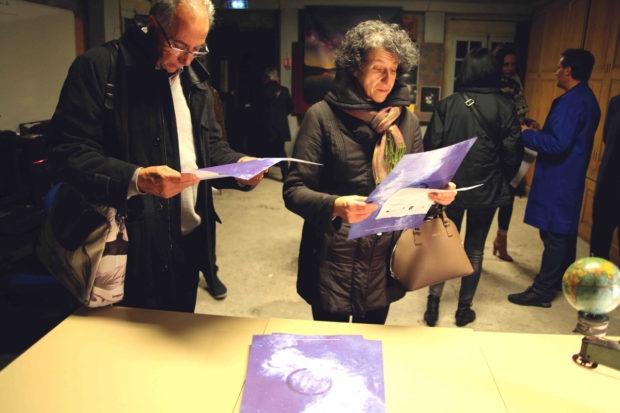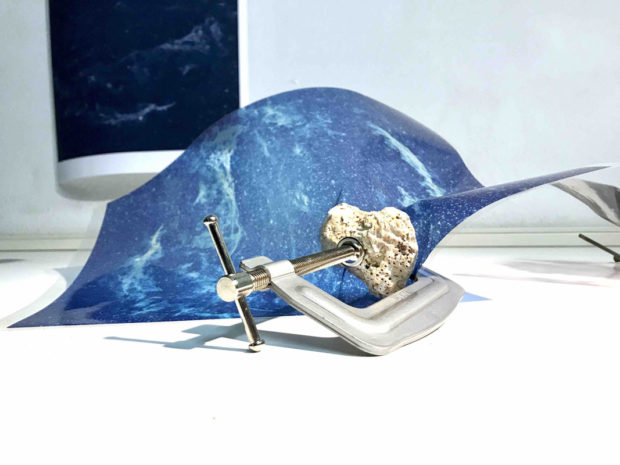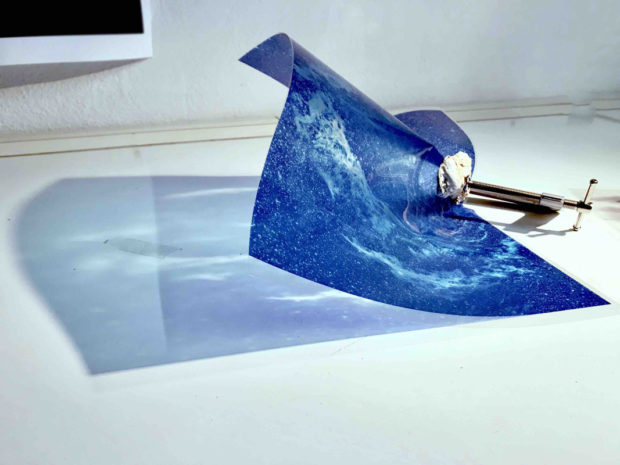Federica Di Carlo (1984) recounts about her work rooted in the interest towards the perception of nature, a dimension where to look for paths that drive to new fields of knowledge. In particular, she retraces her experience with scientists and phisicists from various parts of the world, including the ones she met during the residency in Montpellier (France) at the Bureau des Arts et Territoires that she recently concluded within the European project The Spur ETACEC 16-18, in partnership with the Atelier Brousse.
E. G. Rossi: In your statement you claim that your work is an attempt to ‘reconnect humans with the perception and observation of nature’. ‘Observation,’ ‘perception’ and ‘nature’. Perhaps we could pause for a moment to look at these terms, to consider them as representing a ‘nature’ where the hybridisation of the organic and inorganic has now become a matter of fact. What do these terms mean for you?
Federica Di Carlo: ‘Observation,’ ‘perception’ and ‘nature’ – these have always been essential tools for man to try and understand the secrets of life. Through these concepts, this little human being has “evolved” so much that, in the wake of the Industrial Revolutions, he has convinced himself that he and nature are two separate entities. Man has built mental boundaries, followed by physical ones, linguistically overturning the meaning of these concepts, until he launched himself into a post-natural world. To answer the question what these words mean for me, the incredible sentence written by Schopenhauer, and which I used in one of my installations, springs to mind:
“Every person takes the limits of their own field of vision for the limits of the world” (Parerga and Paralipomena, 1851)

I’m currently reading an old text by Timothy Morton, Ecology without Nature. The introduction to his new idea of ecology starts from eliminating the word and concept of ‘nature’, as the starting point with which we can ‘rethink’ environmental aesthetics.
Morton speaks of conscious awareness in relation to the Anthropocene, which is happening today, now. It is necessary, therefore, to substitute viewing with the concept of observing, reactivating this lost instinct and reconnecting it to conscience. We must grasp the fact that we are the geological agents changing the Earth’s physical processes; that this climate crisis, this crisis of Nature is also a crisis of cultural imagination. A crisis of Art. Therefore, rather than transcending nature, overcoming it, I would say that the term ‘rectify’ could be the one that “frees” us. Rectify the idea invented by man in the last century, the idea of a calm, affable, unchanging nature that never challenges normative bourgeois customs.
We are being ‘rectified’ by Nature itself.

Always in his Introduction of Ecology without Nature, Morton claims that ‘a theoretical reflection can only occur if thought itself is slowed down’. This reminds me of the informal chat we had a while ago, when we spoke about research and its methodology…
As I was telling you, my European residence with The SPUR project in Montpellier, in France, at the Bureau des Arts et Territoires came to an end in December. Compared to other experiences, such as the one last year at MASS MoCA, where I was required to produce a final project, this time I had the privilege of actually doing research alongside scientists for two whole months.
I was reminded of what it is meant by slowing down. The possibility of going back to study at a different pace, leaving the thought process to ‘decant’ so that authentic reflections could emerge, had become an urgent need made impossible by endless appointments and deadlines. In this unexpected condition, I asked myself if thought, like the corporeal life of an artist, responded to Newtonian principles of dynamics.
In the end, I reached the personal conclusion that, in this historical period of violent transitions, it is necessary to re-appropriate the right timeframe in order to think about cultural, scientific, ecological, philosophical and other subjects. How can we produce a powerful idea if we haven’t got the time to think? The more we accelerate, the more we need to slow down.

Since you first became interested in these topics what has changed in ‘your’ way of perceiving nature?
When I was a young girl growing up in my family home in Emilia Romagna, I spent many hot summer afternoons observing the eusocial systems of ants. I followed their routes, sometimes tracing them on a piece of paper to better understand them. At that time I wasn’t aware, however, of what I was trying to understand.
You could say that as a human being I’ve always been extremely curious, passionate about the way the world worked and, later on, especially about ‘physics’ which is nothing other than ‘nature’. I continued to apply this mode, unconsciously, in my life as well as in my artistic research, and this has led me to the awareness that I’m not a spectator in a nature that is silent, beautiful, hospitable … submissive.
But that I myself am nature and that I should remind myself, whenever possible, that ‘Nature’ isn’t kind, bad or indifferent, but constantly evolving.
Using the words of the surfer and writer Finnegan, when he spoke of his relationship with waves:
«At sea, everything is disturbingly interlaced with everything else (…) And yet waves are of course not alive, not sentient, and the lover you reach to embrace may turn murderous without warning. It’s nothing personal. That self-disemboweling death wave on the inside bar is not bloody-minded… Wave love is a one-way street. This is the point.»

You explore nature and the boundaries of what’s visible, with particular attention to perception. In your opinion, what role does perception play in making reality concrete? What does ‘reality’ mean to you?
It indicates the totality that constitutes the “outside”.
With a series of works, such as Untitled /The Unbearable lightness of being (Mass MoCA, 2016 and Rome, Swiss Institute, 2017), you ventured into the dimension of ‘borders’ with everything concerned with their crossing, control and also destruction. You have currently developed this research through readings as well as through conversations with physicists and scientists. You have just ended a residence experience in Montpellier. Can you tell us what fresh avenues this research with new interlocutors has opened up?
My artistic research revolves, in an autonomous way, around this very wide concept. The boundaries of the body, the sea as border and the borders of the universe. Everything that exists is a border, if interpreted freely, especially the light which always features in my works.
The body of work “Untitled /The Unbearable lightness of being” emerged from the need to recount our emotional violation through the violation of the border between man and the earth’s atmosphere.
The residence in Montpellier should have been a continuation of the mapping of these broken skies on French territory. Instead, as so often happens when researching, I found myself looking further afield. I simultaneously collaborated with two groups of scientists who were engaged in observing and traversing the earth’s atmosphere from two completely different observational viewpoints and who had not communicated with each other: the astrophysicists of the Laboratoire Univers et Particules de Montpellier, who look with their telescopes from earth to outer space, and the engineers of the Station de Réception Directe GEOSUD – Maison de la Télédétection – Pôle IRD who, with their satellites, observe earth from the universe.
This double gaze created a new overall vision, so at the end of my residence, even though this wasn’t a requirement, I felt like giving back an ‘artistic act’ to the city and the people who had welcomed and inspired me.
After a series of difficulties, I managed to open La Tour de la Babote to the public, even if only for one night. This is the city’s first Medieval astronomic tower and the headquarters of the Société Astronomique de Montpellier. Only small groups were admitted at a time and the majority of people had never previously visited the interior. On the first and second floor, they knew they would be welcomed by scientists in blue coats who they could talk to, starting with three questions: What is a border? / What is blue? / What is research?
I ultimately returned my residence to the people, including my questions, my interviewees and the privilege of being welcomed as a foreign artist inside a “tower that looks at the sky”.

How would you define the exchange between art and science? Can these two languages tune in to the same frequency? If yes, how?
“It is probably true quite generally that in the history of human thinking the most fruitful developments frequently take place at those points where two different lines of thought meet. These lines may have their roots in quite different parts of human culture, in different times or different cultural environments or different religious traditions: hence, if they actually meet, that is, if they are at least so much related to each other that real interaction can take place, then one may hope that new and interesting developments may follow.” (Heisenberg)
I believe that what Heisenberg wrote back then reflects exactly what is needed today. The need for voluntary interference, an exchange between art and science because, ultimately, both worlds feed off the imagination. Scientists, like artists, dedicate their entire lives to imagining the impossible. Over the course of centuries a kind of division has been created, compartmentalising roles and responsibilities. Now, in this state of general breakdown, the antennae are being retuned; there is a new-old willingness to listen.
Because of my artistic research, I often find myself in scientific spaces such as INAF, MIT, CERN, etc. I understand that much as we are fascinated by their numbers, deductions and physical laws … and viceversa, scientists are captivated by the way art seizes, picks up on and anticipates these processes, synthesising them in visible works. Many scientific departments and companies that work with technologies invite artists to take part in their research, to contribute their vision. The hybridisation of art and science is developing into a trend, if you like, a channel to be exploited or a new channel of discovery.

Let us go back to the Montpellier residence. What were you expecting to find and what did you actually find?
Montpellier was a revelation, not only because the city is beautiful, but also for the opportunities it gave me. I didn’t know anything about the French art system. Actually, France had never really appealed to me, but I’ve been positively impressed. Artists exist because the State supports them, recognising their contribution to culture as added value and this facilitates artistic and cultural research.
During my two months of residence, I asked local citizens and scientists why was it that the city was considered blue. The majority of respondents said, “Because of the colour of the sea and the sky”.
The sea and the sky are the visible limits that unite and separate everything on earth; they expand, shrink and invade, defining the surrounding space by responding to specific physical laws.
Starting from here, from the blue that is arbitrarily attributed to the city of Montpellier, I found myself questioning how a colour could become a boundary, and viceversa, and how the physical borders of sky, sea and atmosphere could change a concept.
With the help of scientists I tried to understand to what extent blue was an essential colour within their discoveries and the world’s equilibrium.
This is how the new work entitled The sea is blue because you want to know why the sea is blue came into being. In this piece I go back to a haiku poem written by Jack Kerouac which said, “The sky is blue because you want to know why the sea is blue”. I substituted the word “sky” with “sea”.
My intention was (and will be) to cross this colour-border starting from the questions we have asked since our childhood on why the sky and the sea are blue – linked to the physical law that governs this optical illusion, known as the “Raman effect” (from the Indian scientist who discovered how it worked in 1928) – in order to arrive at poetic reflections on existence.

Can you give us a preview of the project that emerged from this research experience, even if only about its direction?
One of the bodies of work, part of the project ‘The sea is blue because you want to know why the sea is blue’, goes beyond the sky. The astrophysicists in the Particles Department at the University of Montpellier gave me some black and white images of universe nebulae (an interstellar mass of dust, hydrogen and plasma which is only ‘visible’ to scientists through light). I manipulated these images, taken with their telescopes, by adding a specific ‘blue’ filter to invent what I defined as a Blue marine-atmosphere.
I liked the idea of visualising an atmosphere that does not exist, where sea and sky are united like two lovers. In the end I compressed and crumpled up my blue marine-atmospheres with local shells, similar to fossils and meteorites, found along the French coast (symbol of the city), inside a vice until the breaking point, the tension, between the materials was reached. There is a plan to make an entire environmental installation where visitors find themselves inside a room, passing through enormous and precariously balanced blue marine-atmospheres to question, once again, the violation of borders between nature and man.
Federica Di Carlo
images: (cover;8) Federica Di Carlo, «The sea is blue because you want to know why the sea is blue», 2017, video frame ( 1) Federica Di Carlo, «The sea is blue because you want to know why the sea is blue», Performance-Tour de la Babote, Montpellier, France. From left to right: Piron Frédéric Astrophysics -Expérimentateur CNRS /Reboul Henri Astrophysics – Maître de Conférences émérite Laboratoire Univers et Particules de Montpellier /Lopez Jean Mariepresidente of the Société Astronomique de Montpellier/Bernardini Maria-Grazia Astrophysics – Expériences et Modélisations en Astroparticules /Bastien Nguyen-duy Bardakji (engineer of the station GEOSUD-Maison de la Télédétection – Pôle IRD (foto 3-4-5) Federica Di Carlo, «Out of the Blue (blue marine atmosphere, vice, shell fossil)», 2017 (foto 6-7-) GEOSUD – Antenne, Maison de la Télédétection – Pôle IRD (foto 8) Federica Di Carlo, «The sea is blue because you want to know why the sea is blue», 2017, video frame.









































